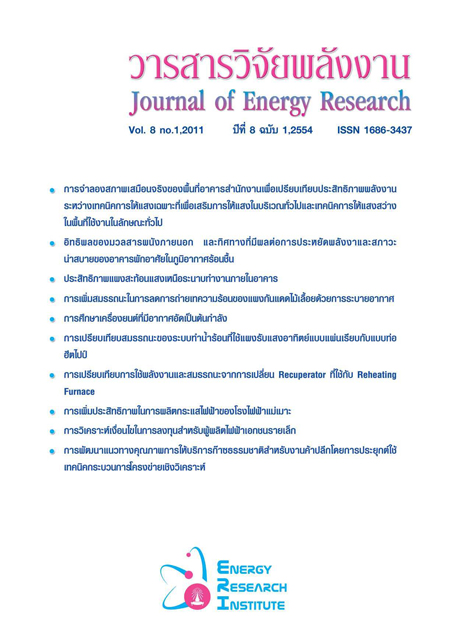การเพิ่มสมรรถนะในการลดการถ่ายเทความร้อนของแผงกันแดดไม้เลื้อยด้วยการระบายอากาศ
Main Article Content
บทคัดย่อ
การใช้พืชพรรณปกคลุมอาคาร ทำให้เกิดภาวะน่าสบายทางอุณหภูมิ (thermal comfort) แก่สภาพแวดล้อมทั้งภายใน และภายนอกอาคารจากการลดการถ่ายเทความร้อนเข้าสู่อาคาร โดยการป้องกันรังสีจากดวงอาทิตย์ ดูดซับรังสีดวงอาทิตย์ส่วนหนึ่งเพื่อนำไปใช้ในการสังเคราะห์แสง (photosynthesis) และการคายน้ำ (evapo–transpiration) ทั้งยังลดการแผ่รังสีและการสะท้อนกลับสู่บรรยากาศภายนอก ลดอุณหภูมิโดยรอบอาคาร และอุณหภูมิภายในอาคาร ยิ่งมีความหนาแน่นของใบปกคลุมมากและจำนวนชั้นของใบมาก ก็ยิ่งมีสมรรถนะที่ดียิ่งขึ้น ทำให้เกิดการประหยัดพลังงานแก่อาคารอย่างมีประสิทธิภาพ
งานวิจัยนี้ได้ทำการศึกษาการใช้พืชพรรณประกอบอาคารโดยมุ่งเน้นที่การใช้ไม้เลื้อยที่ใช้เป็นแผงกันแดดแนวตั้งให้แก่อาคารที่ใช้การระบายอากาศธรรมชาติ ซึ่งหันสู่ทิศตะวันตก โดยทำการทดสอบคุณสมบัติในการลดการถ่ายเทความร้อน สู่ภายในอาคารเปรียบเทียบกับอาคารที่ไม่ใช้แผงกันแดดไม้เลื้อย เพิ่มการระบายอากาศแบบธรรมชาติและแบบเครื่องกล เพื่อทดสอบสมรรถนะที่เพิ่มขึ้น
ผลการทดลองพบว่าแผงกันแดดไม้เลื้อยมีสมรรถนะในการลดการถ่ายเทความร้อนจากอากาศภายนอกได้ดีที่สุด เมื่อมีกระแสลมแรงที่สุดจากการระบายอากาศตามธรรมชาติ สามารถ ลดอุณหภูมิได้มากที่สุด 9.93 องศาเซลเซียส เฉลี่ย 3.63 องศาเซลเซียส เมื่อเปรียบเทียบกับห้องธรรมดา ในช่วงเช้าถึงค่ำ 9.00-20.30 น. เมื่อกระแสลมอ่อน ในกรณีเปิดพัดลม 1 ตัว แผงกันแดดไม้เลื้อยสามารถลดอุณหภูมิจากห้องธรรมดามากที่สุด 6.72 องศาเซลเซียส เฉลี่ย 0.91 องศาเซลเซียส ในเวลากลางคืนห้องที่ใช้แผงกันแดดไม้เลื้อยมีอุณหภูมิสูงกว่าห้องธรรมดาและอากาศภายนอกในทุกกรณี ในช่วงที่เพิ่มการระบายอากาศแบบเครื่องกลด้วยพัดลม 2 ตัว สามารถทำให้มีความแตกต่างอุณหภูมิน้อยที่สุดที่เฉลี่ย 0.71 องศาเซลเซียส เมื่อเปรียบเทียบกับห้องธรรมดา และ 0.2 องศาเซลเซียส เมื่อเปรียบเทียบกับอากาศภายนอก ตามลำดับ นอกจากนี้การใช้แผงกันแดดไม้เลื้อยปกคลุมหน้าต่างมีสมรรถนะในการลดอุณหภูมิภายในห้องสูง เมื่ออากาศภายนอกอุณหภูมิสูงมาก เนื่องจากใบไม้รักษาอุณหภูมิผิวใบและหลังใบไว้ไม่เกิน 37 องศาเซลเซียส และต่ำกว่าอุณหภูมิอากาศเสมอ จากการทดลองทั้ง 4 กรณี แผงกันแดดไม้เลื้อยไม่สามารถทำให้อากาศภายในห้องอยู่ในภาวะน่าสบายทางอุณหภูมิได้ แต่สามารถนำมาใช้ประโยชน์ในการลดอุณหภูมิของอากาศนำเข้าสู่ระบบปรับอากาศ เพื่อการประหยัดพลังงานได้อย่างมีประสิทธิภาพ
Increasing Thermal Performance of Climbing Plant Shading by Adding Ventilation
Facade greening enhance thermal comfort to indoor and out door environment by reducing heat gain to building, protecting from solar radiation, absorbing solar radiation for Photosynthesis and Evapo-transpiration, reducing radiation and reflection to outdoor environment, reducing temperature outdoor as well as indoor. The more leaf coverage and leaf layers, the better thermal performance and the more energy efficient to all buildings applied.
This research aim to study the use of climbing plants as vertical shading device “Biofacade” for naturally ventilated building, with window facing west. Four experiment were carried out to compare temperature of room with “Biofacade” and room without, adding natural and mechanical ventilation to both rooms and compare the increasing performance.
It was found that “Biofacade” has best performance when wind speed is high from natural ventilation mode, reducing temperature from ambient air to the maximum of 9.93 degree celcius, average of 3.63 degree celcius in the day time (9.00-20.30). When windspeed is low, “Biofacade” has maximum temperature of 6.72, average of 0.91 degree celcius lower than normal room. At night ( 21.00-8.30) “Biofacade” has higher temperature than normal room and ambient air in all cases. By increasing mechanical ventilation with 2 exhaust fans,the nightime difference came down to average of 0.71, 0.2 degree celcius from normal room and from ambient air accordingly. Besides, the higher temperature of ambient air, the better performance in heat gain reduction since leaves maintain surface temperature under 37 degree celcius and always below ambient temperature. From the 4 experiments, the room temperature with “Biofacade” never came down to comfort zone during the day time. The application can be recommnended to use for pre-cooling the air-intake of the air condition system, so it can reduce cooling load efficiently.

